

Is There a Wildfire On My Hike? Wildfire Tips for Hikers
As a hiker, dealing with wildfires is more and more of a reality these days. As with most things hiking, being prepared and informed goes a long way toward safely dealing with wildfires. First off, you're going to want to know if there's a wildfire affecting your hike. And when you're out on the trail, you're going to want to know how to deal with wildfires that pop up. In this guide, we'll cover it all.
- Where To Find Trail Closure Notices
- Tracking Wildfires Over a Trail Map
- Preparing For Wildfires When Hiking
- What To Do If You Encounter a Wildfire
A big thanks to my numerous friends at CalFire and the U.S. Forest Service whose shared their wisdom and insight for this guide.
Is There a Wildfire On My Hike?

A common scenario is that you see a wildfire on TV and you're not sure if it's going to affect your hike. Wildfires often have generic names like "the Apple Fire" that don't tell you a lot about where it is. The first thing I generally do is check the Inciweb website to see what fires are happening now.


It's important to note that even if your hike isn't in the wildfire area, the entire jurisdiction may be closed.
If your wildfire isn't on Inciweb, your next step is to check the state and local fire incident websites. For example, in California, we have the CalFire site which has fires that may not make it onto Inciweb (at least initially).
Once I know where the wildfire is, I'll go to the park or municipality Twitter page and check for any closures and fire updates. In my experience, Twitter usually has the most up to date closure information.
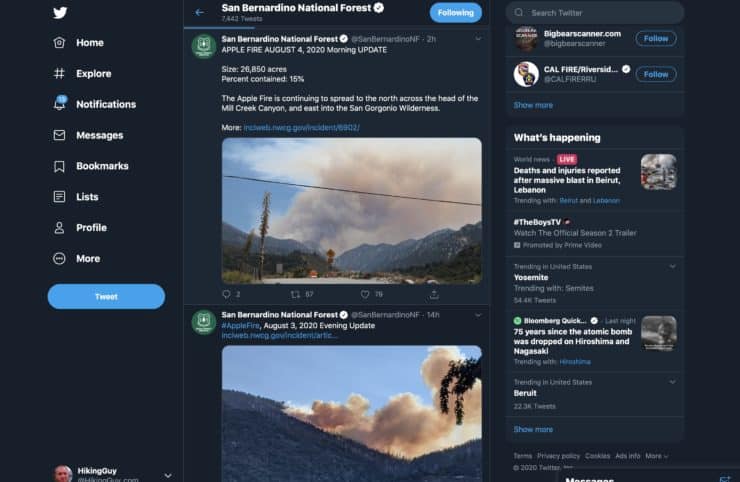
Tracking The WildFire In Detail
If you want to dig down and see a fire in detail, I recommend Caltopo.com, which is a powerful mapping website that I often use to plan and analyze hikes. Caltopo has a layer called "Fire Activity" that you can switch on and get the latest fire reports overlayed onto a map of your choice. You can then overlay other imagery, such as daily satellite photos, that let you see where the smoke is blowing, and then deduce the likely path of the fire.

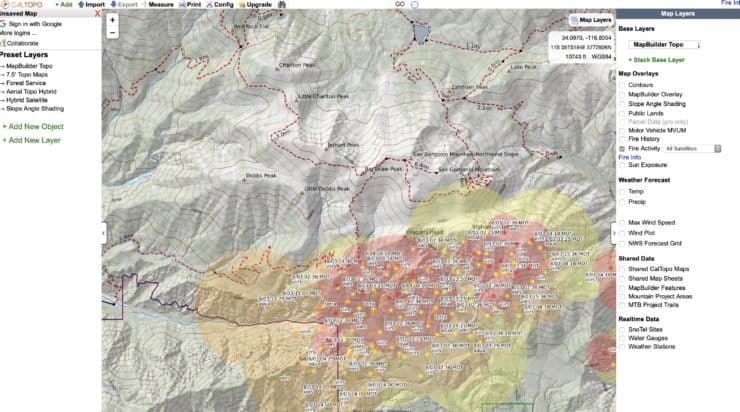
Fire Tracking Video
Update!

Being Prepared For Wildfires On Your Hike

I know I don't have to say it, but I will. If there's an active fire anywhere near the area that you are going to hike, don't go. And as I mentioned earlier when talking about CalTopo, if your hike is in the path of the smoke, give your lungs a break and go somewhere else. Here's what I recommend that you do to prepare for a wildfire on your hike.
- Check the park website and conditions (as previously described) before you head out the door.
- If the website or Twitter mentioned a "prescribed burn," they are referring to a controlled wildfire intentionally set to clear an area. These generally happen in the wetter or winter months and you need to avoid these as you would a wildfire.
- Carry an InReach device which lets you communicate in the backcountry where there are no cell phones. If you see a wildfire or big column of smoke nearby, you can hit the SOS button. From there you can report the fire and get information and evacuation recommendations from rescue coordinators.
- Hopefully you've looked at your hike route on a map before you head out. When you do, take a look at neighboring trails and understand what alternate routes you can egress on if your intended hike route gets blocked by fire.
- Get a campfire permit if you plan on using a stove (even the little camping ones).
- If you are using a camping stove, make sure it's on level, solid ground before you ignite it.
- Don't start open fires in the woods outside of designated ring fire installations.
- If for some reason you are waiting for a rescue and start a signal fire, make sure that you've done so at least 10 feet away from vegetation and that you always keep it under control. One of the biggest wildfires in San Diego history, the Cedar Fire, was started from a lost hunter's signal fire.
- Whenever you have a chance to register for a voluntary permit or sign a trail register, do it. If you get trapped by the fire, that information will help inform your rescuers.
- Listen to this REI podcast series on the Eagle Creek Fire. The podcast has several episodes and does a great job of covering a wildfire from every angle, including that of hikers trapped.
Want to see the wildfire history in CA? This is another cool website that visualizes it on a map (thanks to David C).
What Happens If I See A Wildfire On My Hike?

The thing to do is to get out as soon as possible. Getting out may be a challenge depending on where you are relative to the fire. You are going to have to stay calm, make a plan, and then get moving. In a situation like this, having an InReach device and hitting the SOS button is absolutely the best thing you can do. You will be connected with a team of professionals who can guide you out based on real-time conditions and maybe even organize an evacuation if it makes sense. If you don't have an InReach, it's going to be a little tougher.
- Understand the Fire
- Plan to retreat in the opposite direction of the fire. The direction of the smoke column is generally the direction of the fire. Know that if the wind changes, the direction of the fire can change, and you'll need to adjust.
- You're not only avoiding the flames, but also the smoke, which can kill you.
- Learn how to read the smoke and try to use that information to locate the fire on a topographic map.
- Light or white smoke generally indicates a quick-burning fuel like a grass or scrub area.
- Darker smoke indicates a heavier fuel like timber.
- The bigger the smoke column, the bigger the fire.
- The fire will travel uphill faster than downhill. In the mountains, fire can funnel up chutes and towards saddles where the wind is strongest.
- Know that fires can move at up to 15mph in heavy winds. That's probably faster than you ride a bike. Most people hike uphill at about 1-2mph and downhill at 2-3mph.
- Get the Hell Out
- If you can, travel in the opposite direction of the fire.
- Don't try to outrun the fire unless it is your only option. Most wildfire deaths occur when trying to outrun a fire. If you do have to try this, drop any gear that is not essential.
- Try to travel parallel to the fire and get out of its path, or even circle back around it.
- If you are trapped in the path of the fire, try to find an area where you can take refuge. You're looking for a spot where there isn't fuel to burn like a clearing, rocky areas, or water.
- If you can crest a ridge and descend from the fire, that's generally a good move.
- The safest place to be is behind the fire in an area that it has already burned. Watch out for hot ash and smoldering areas.
- Call 911 and report the fire after you get back to safety.
In most firefighter fatalities ... the unsuccessful strategy has been to try and run away from the fire and continue running until exhaustion or the radiant heat load from the fire front fells the victim and allows the flame front to pass over him or her. Australian Forest Research Report on Wildfires
My Wildfire Story
What Happens If I Get Caught In Fire
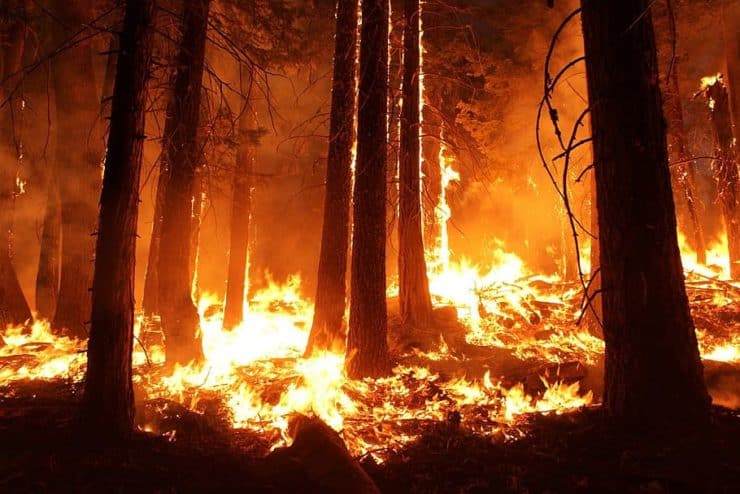
Let's say the worse happens and you are trapped. The good news is that many people have survived in this situation, and you have a chance to survive too. The key word is "chance;" folks have died using these methods too. But if there's no escaping the flames, it's time to start fighting.
Burn Out a Safety Area
When trapped by a wildfire some Native Americans would "burn out" a safety area. The idea is that you burn down a section of the wild and take refuge in it so that when the main wildfire arrives, there will be no fuel in your burned out area. It's an option to use with care; you wouldn't want to start a new wildfire. But if you think you can make this happen and the area you are in will surely burn anyway, it's a smart option. Hopefully you've got fire-starting materials with you. And of course, make sure you are upwind of the area that you want to burn.
Break Through the Fire
The idea is that by running through the flame front, you minimize your exposure and quickly get to the safe burned-out area behind the fire. Ideally you'll move toward the flank of a fire or an area where there isn't intense fuel and flames (like a clearing) and make a break through the wall of the fire. It might seem crazy, but people have survived, albeit with serious burns, by using this method.
Hunker Down
If the flames are going to engulf your location and there's no getting out, hunkering down is your move.
- Try to shelter behind or within landscape that won't burn like boulders or rocks. Avoid anything that may ignite from not only flames, but also extreme heat.
- If you have clothing options, try to avoid synthetics, which can combust easier than most natural fibers. Wet your clothing down if you have water.
- If the fire is going to go over you, lie flat on the ground and cover yourself in non-flammable debris like dirt if possible. Firefighters have survived in blazing fires by staying under fire shelters. You probably won't have a fire shelter with you, but whatever you can do to improvise is worth a try.
- Dig a hole for your face and keep your nose and mouth in the dirt. Don't get up high and inhale superheated air; you will die.
If You See An Open Campfire

Not all open campfires in the backcountry are illegal, it just depends on where you are. But the fire danger can be massive, especially if the conditions are very dry. And even when a campfire is not illegal, most folks with good intentions just don't understand the risk involved. The sad fact is that most wildfires start from campfires.
When I encounter folks in the backcountry with open campfires, I'll say hello and start a friendly conversation. Then I ask about their intentions with the fire. That's a good time to bring up the fact that most wildfires come from campfires and ask them to ensure that they put the fire out completely. And if their fire is illegal, you can gently bring up that point as well. Most of the time when this happens, people are very apologetic and didn't realize what the situation was.
I've only had one time where people learned that a fire was illegal, but wouldn't put it out. I ended up hiking out, calling 911 and reporting it. I didn't care how much they said they had it under control. The fire was putting people's lives in danger, and that's a problem.
And sometimes you come across an abandoned campfire or smoldering fire. To put it out, douse it with water or dirt, and stir up the embers and dirt with a stick. Scrape any embers off of burning wood and put them out. Then bury the whole thing.
90% of all wildfires are started by humans - National Park Service
Need More Info?
- Have a question about the guide? Join my Patreon and ask me a question.
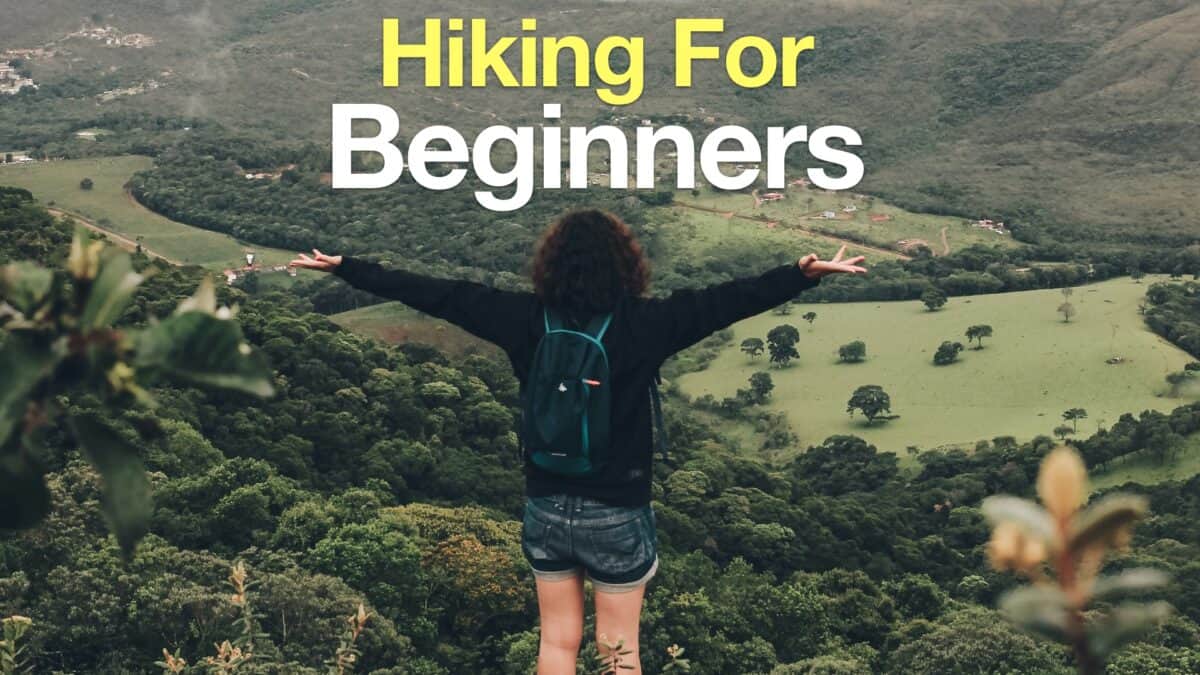 Hiking For Beginners: 11 Essential Tips
Hiking For Beginners: 11 Essential Tips In-Depth Garmin inReach Mini Review
In-Depth Garmin inReach Mini Review How to Hike
How to Hike Best Hiking Gear 2024
Best Hiking Gear 2024 Hiking Boots or Shoes: Do I Really Need Hiking Boots?
Hiking Boots or Shoes: Do I Really Need Hiking Boots?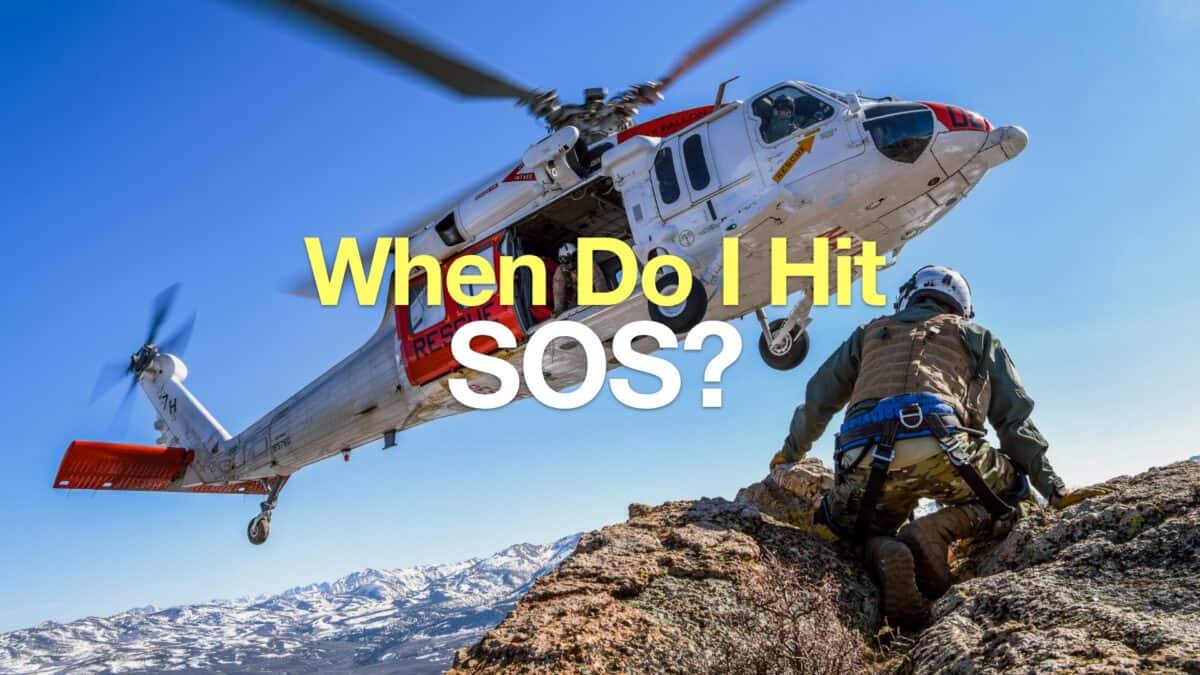 When to Hit SOS on inReach
When to Hit SOS on inReach